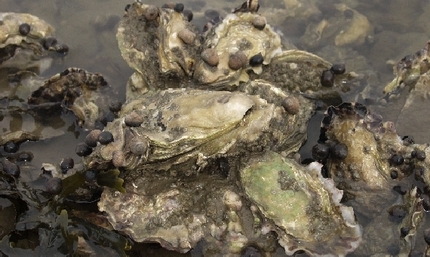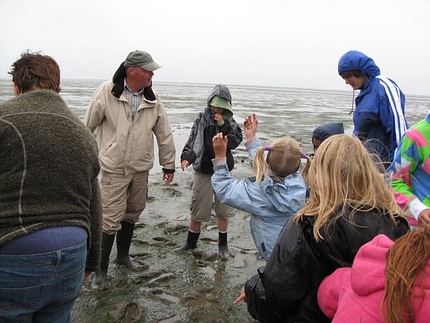The invasive species Pacific oyster has spread rapidly in the Wadden Sea in recent years. The oysters create problems for the Wadden Sea ecosystem, but are also an opportunity for attracting tourists to the area.
Dressed in warm clothes and waders, a group of people stand at
the water's edge on the island of Rømø waiting for the leader of
their expedition, Ivar Gram. He is a nature guide and owns the
nature tour company Sort Safari. In a minute, the hunt for
Denmark's new natural resource will begin, and it is not gold
washed up in the Wadden Sea the group is hoping to find, but close
enough. It is the exquisite Pacific oyster.
The hunt begins. They are two hundred meters out on the intertidal
flat between the Rømø dike and the Hindenburg dike, which connect
the island of Sild to the German continent. This is where the large
oyster bed is, in what is the cleanest tidal area in the entire
Danish Wadden Sea. And what is more, there are enough oysters
to go around for everyone; in half a hectare's space, there is more
than one tonne of oysters.
"When we have gathered as many oysters as we please, we will return
to the coast and the old ruin of the castle Trøjborg. In the 1500s
and 1600s, you could harvest oysters in the Wadden Sea if you had a
permit from the King. So the group gets to hear about the history
of oysters in the area while they eat the oysters that are here
today, usually accompanied by a glass of wine," Ivar Gram
tells.
The Pacific oyster is here to stay
As the name indicates, the Pacific oyster originally comes from the
Pacific Ocean, more precisely from Japan and southeast Asia. The
species was introduced in commercial sea farms in the Dutch part of
the Wadden Sea in the 1960s, and in the German Wadden Sea in the
1990s. The Pacific oyster is attractive commercially amongst
other things because it is characterised by very rapid
growth.

Pacific oysters. Photo: Ivar Gram
The species was first observed in Danish waters in 1996. In
2005 there were already densely populated oyster beds in the
southern part of the Danish Wadden Sea. Today, Pacific
oysters have also been observed in the Limfjord (in northern
Jutland), the Isefjord (in northern Zealand), as well as in other
areas of Denmark.
When oyster farming began in the Wadden Sea, no one thought that
the Pacific oyster could spread outside the sea farms. This is
because the species requires relatively hot water temperatures of
more than 20°C to spawn. It is therefore believed that one of
the main reasons the species has spread so extensively throughout
Danish waters today, is because the hotter climate of the recent
years has increased the water temperature enough to allow the
Pacific oyster to spread unhindered.
This has meant that in the autumn of 2007, there was an estimated
6,300 tonnes of oysters in the Wadden Sea. At the same point in
time, there were only just under 12,000 tonnes of common mussel, an
indigenous species in the Wadden Sea. These numbers have presumably
gone down following the recent harsh winters, where ice cover has
led to frost damage and oxygen depletion in shallow waters, which
could have killed up to 50% of the population. However, Ivar Gram
is convinced that the Pacific oyster will continue to spread in the
Wadden Sea.
"Pacific oysters grow and spread incredibly fast. They are here
now, and we will probably never get rid of them again," says Ivar
Gram
A problem for indigenous species
The Pacific oyster forms beds and reefs in the same places as the
common mussel. Because of its fast growth and lack of predators, it
is feared the Pacific oyster will displace the common mussel. The
common mussel is an important food source for many eiders,
oystercatchers and herring gulls, and these birds cannot readily
replace common mussels with oysters.
"I have observed oystercatchers successfully peck open a Pacific
oyster. But I have also seen more than one oystercatcher with
an oyster shell stuck around its beak or foot, which I know they
won't survive with for long. So just now, the Pacific oyster has no
natural enemies," says Ivar Gram.
One way of curbing the spread of the Pacific oyster, is to fish or
dredge the oysters from the seabed. In the summer of 2007, the
National Institute of Aquatic Resources at the Technical University
of Denmark carried out trial fisheries in which the oysters were
either harvested by hand or using various dredging tools. The
problem with oyster fisheries is that the dredging tools used can
interfere with the seabed, and have negative impacts for the seabed
habitat and ultimately for the birds.
According to Ivar Gram, trying to remove the Pacific oyster from
the Wadden Sea is an impossible battle to win.
"It is a hopeless task. We have strike a compromise and accept
them, as I say to my guests: just eat them. As many as you can; the
more the better."
Research also describes the possibility of the Pacific oyster and
the common mussel coexisting in the Wadden Sea, without being a
threat to each other's existence. This is possible as the two
species vary significantly in their distribution patterns.
Attracts new tourists to a rural area
Usually, between 20 and 50 paying guests participate in Sort
Safari's oyster safari, which is held once a week during summer and
twice an month during winter. There are guests from the local area,
from throughout Denmark and also from Sweden. The Swedes find going
on an oyster hunt to Denmark exotic. Besides Sort Safari, others
also arrange oyster hunts, including the Wadden Sea Centre, the
Fanoe Tourist Office and Nature Centre Tønnisgård.

Oyster hunting group. Photo: Ivar Gram
The many visitors to the Wadden Sea are economically important to
this area, one of Denmark's most sparsely populated.
"It is important economically, because it gives a boost to nature
tourism, which is a budding industry in the Wadden Sea area. Most
people predict that once the Wadden Sea National Park has been
established, nature tourism will grow. Oyster hunts, oyster
safaris, or what you want to call it, can add an additional element
to the nature experience, and can help attract more tourists," says
Ivar Gram.